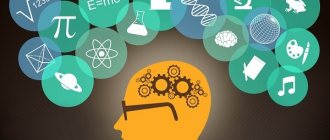The mental world of people is diverse and versatile. A high level of mental development provides a person with numerous opportunities, but mental development would not take place without preserving acquired experience and knowledge, and this is ensured thanks to memory. For several centuries, representatives of various sciences have been studying memory. Among them are psychologists, biologists, doctors, geneticists, cybernetics and many others. A representative of each of these sciences has its own system of concepts and its own theories of memory, but they all help expand human knowledge about it.
Association theory
The oldest are psychological teachings, since medical, genetic and biochemical theories and laws of memory appeared much later. One of the first, which is still relevant today, is the associative concept. The period of appearance of this theory of memory is the 17th century, and its most active development occurred in the 18th and 19th centuries.
The associative theory of memory is based on the concept of association, in other words, the connection between different mental phenomena. The founders of this teaching are G. Ebbinghaus, A. Pilsecker and others. They considered memory as a complex system of associations, regardless of whether they are short-term or long-term, more or less stable. Representatives of this theory of memory divided associations by contiguity, contrast, similarity, spatial and temporal proximity.
The associative theory of memory has made it possible to understand some of its laws. Psychologists working in this direction have established the peculiarities of changes in the number of elements that are remembered with different numbers of repetitions of the presented series, as well as the peculiarities of storing elements of the memorized series in memory, depending on the period of time elapsed between memorization and reproduction. It was thanks to this teaching that many other basic theories of memory were subsequently founded.
Memory training exercises
Exercises for memory development:
- Look at the pyramid of numbers, memorize it line by line. The time for memorization is unlimited. Write down from memory those numbers and exactly in those rows that you remember.
- Write a story that includes all the words below. First remember them all, and then write the story. Check if all the words are in your text.
- A more difficult exercise. Look at the dots and lines in the first picture for 60 seconds, then add the missing lines in the second picture.
- Look at the animals below for 60 seconds, then write them down in alphabetical order from memory.
Gestalt theory of memory
After the associative theory encountered a problem that it could not answer (we are talking about explaining the selectivity of memory), it was replaced by another theory - Gestalt. The initial concept in this teaching was the original, integrity of the primary elements - gestalt. Proponents of this theory are convinced that it is the principles of gestalt formation that determine human memory.
This concept emphasized the importance of the fact that material to be memorized and reproduced by a person must be structured, brought to integrity and organized into a system. Particular attention was also paid to the role of human intentions and needs; by the way, this is what representatives of Gestalt theory explained the selectivity of mnemonic processes. The main idea of its adherents is that the material (both when memorizing and reproducing) represents an integral structure, and not a random set of elements formed on an associative basis.
Gestalt theorists explain the dynamics of memorization and reproduction as follows: at each individual moment in time, a person has a certain need that contributes to the creation of an attitude towards memorization or reproduction. The installation, in turn, animates the necessary integral structures, which are the basis for memorizing or reproducing the material.
Despite the fact that representatives of this theory found psychological explanations for many facts of memory selectivity, they were unable to solve the problem of the formation and development of human memory in phylo- and ontogenesis. Motivational states that determine mnemonic processes in humans are predetermined - this is exactly how representatives of the Gestalt theory of memory imagined memorization. Briefly, the shortcoming of this doctrine can be expressed as follows: it did not pose and did not try to resolve the issue of the dependence of the development of a person’s memory on his practical activity.
Memory and recollection processes
The phases of memory are divided into remembering, storing, recalling and forgetting.
Memorization is the process of consolidating new information by encoding it and linking it with existing experience.
The peculiarity of memorization is selectivity. Not all information that enters the brain is recorded and remembered. This is explained by selective attention. Memorization can be:
- involuntary and voluntary;
- mechanical and meaningful.
Preservation is the retention of information, as well as its transformation and processing. This process has been poorly studied by scientists; it is only known that it is carried out unconsciously, processing occurs during sleep.
To preserve memorization and retain information, an important component is the preservation of brain structures.
There is a hypothesis according to which a person’s memory stores everything that has been accumulated during life, but consciousness is not able to reproduce this information in its entirety, since it does not have access to it.
Reproduction - updating information in the absence of external indicators. Playback is divided into:
- involuntary - the impression is updated without a specific task;
- arbitrary - “pops up” when there are goals and objectives.
As a rule, during reproduction, information is rearranged - it loses minor details and takes on a generalized form. There are several types of playback process:
- recognition - recognition of an already known object,
- direct reproduction - reproduction of images from the past,
- remembering - retrieving images of the past,
- memory - reproduction of images that are associated with certain periods or events of life.
Forgetting is the process of losing access to previously remembered material. First of all, the information that is forgotten is that which is not updated in solving pressing problems and does not meet pressing needs.
Under certain conditions, reversibility of forgetting is possible - restoration of forgotten material using external and internal conditions under which this memorization took place.
Psychoanalytic theory
Representatives of the psychoanalytic theory of memory, the founder of which is S. Freud, pay special attention to the unconscious level of the psyche when considering the preservation and memorization of information. The psychoanalytic theory of memory shows the significant role played by early emotional experiences that can influence the rest of life. Representatives of this theory pay special attention to the displacement of negative information from consciousness and its manifestation through humor, dreams, slips of the tongue and other manifestations of the unconscious.
Thanks to psychoanalysis, many interesting psychological mechanisms of subconscious forgetting related to the functioning of motivation have been discovered and described.
Habits that develop memory
Here they are:
- Interest and desire to remember - without this, all acquired knowledge will be forgotten;
- Linking the melody with the text (making an association) - this way it will be better remembered;
- Observation - attentiveness in everything helps to remember a lot;
- Organization - storing things in specific places. External and internal order are essentially the same thing;
- Studying information - exaggerating its importance helps to remember it better;
- Figurative thinking - memory retains images longer than words;
- Carrying out daily tasks in an established way;
- Solving charades, scanwords, Sudoku, playing chess;
- Reflection before going to bed about what you need to remember from the events of the day;
- Talking about memories - expressing them in words;
- Linking ideas to images.
You need to study and train your memory at any age. Do not forget about the principles of improving memory - physical activity, proper nutrition, healthy sleep, proper rest, and so on.
Then your memory will not let you down, and at the right moment you can easily extract from it everything you need.
Meaning theory
In the first half of the 20th century, a semantic theory of memory emerged. Its most prominent representatives, A. Binet and K. Bühler, argue that the work of memory directly depends on semantic connections (their presence or absence), which unite the material to be memorized into semantic structures - more or less extensive. Representatives of this theory of memory in psychology pay special attention to the semantic content of the material. In their opinion, semantic memorization occurs according to laws different from mechanical memorization. They argue that the material to be learned is part of a context of certain semantic connections.
Representatives of this theory strive to present memory in the form of the reproduction of pure thoughts, which are completely independent of the speech form. After all, they tear apart and contrast the memorization of words and thoughts, coming to conclusions that are consistent with the antagonistic theory.
Test your memory
Here are two tests you can do yourself:
- Verbal memory. Ask your loved ones to read 15 words to you (even if they are not related to each other). Try to repeat them. Listen to the list of words 4 more times, repeat.
The norm is that on average a person is able to reproduce 12–15 words; people over 45 years old remember less—7–9 words.
After 15 minutes, repeat the words from memory (without reading them first). Middle-aged people can remember up to 10 words.
- Visual memory. Below is a complex figure. Draw it, and after 20 minutes try again. The more details you can remember, the better your visual memory.
Activity theory
French scientists, including P. Janet, founded a new theory of memory, based on considering it as a type of activity. P. Janet is one of the scientists who was one of the first to interpret memory as a system of actions that are focused on remembering, systematizing and storing information. The French school of psychology proved the social conditioning of all memory processes, its direct dependence on human activity.
Domestic psychologists, among whom can be named P.I. Zinchenko, A.N. Leontiev, A.A. Smirnov, etc., continued work on the theory in the study of memory related to the general psychological theory of activity. They considered memory as a special type of activity, part of a system of actions that are subordinate to solving a mnemonic task, namely, remembering, storing and reproducing certain information. Adherents of the activity theory of memory in psychology paid special attention to the study of the composition of mnemonic actions and operations, the dependence of the productivity of memory on the place in the structure of the goal and means of memorization, and the comparative productivity of memorization - voluntary and involuntary.
How does sleep affect memory?
When the body sleeps, the brain continues to actively work, which consists not only of dreams, but also of very important cognitive tasks.
5 simple rules for getting up early. If you are sitting at 2.00 and googling about sleep.
During a person’s sleep, the brain replays everything that happened during wakefulness in order to extract the most important things from everything read, seen and heard. And it will be sent to long-term memory.
Scientists conducted an experiment on rats. They were trained to find food in a maze. Sensors were implanted into the brains of rodents that recorded impulses and neural bursts while the animals were sleeping.
It turned out that rats dream, and impulses were recorded in the same neurons as during movement through the maze.
That is, in a dream, the rats still ran through the maze, and exactly repeated all the movements as during the day (they moved along the same path, stopped where they stopped during the day, and so on).
The path through the labyrinth in a dream took the same amount of time as during the day.
Physiological theory
Physiological theories of memory owe their appearance much to the teachings of I. P. Pavlov, who deduced the laws of higher nervous activity. The scientist argued that the material basis of memory depends on the plasticity of the cerebral cortex and its ability to form conditioned reflexes. The physiological mechanism of memory consists precisely of the formation, strengthening and extinction of temporary and neural connections. The connection between previously fixed information and new information is formed thanks to conditioned reflexes, on which the physiology of memorization is based.
To understand the reason for the conditioning of memory, it is worth turning to the concept of reinforcement, also introduced by Pavlov. It should be noted that psychological theories of memory are based on completely different principles. Pavlov considers this concept as a coincidence of connection with the achievement of the immediate goal of a person’s action or the stimulus that motivates the action. It is this coincidence that leads to the preservation and consolidation of information acquired by the individual. The correlation of the physiological understanding of reinforcement with the psychological concept of the purpose of action is an act of fusion of psychological and physiological analysis of memory mechanisms. The main function of this process is aimed at the future, that is, memorization makes sense only if you ask the question “what will happen.” If you live with the question “what happened,” this process is completely meaningless.
How to develop memory in children: basic principles
It is possible to develop memory in a child faster than in an adult, however, it is important to consider the basic principles:
- Changing the type of activity - listening to a fairy tale should be combined with looking at and discussing illustrations, alternating drawing or modeling with outdoor games, and diversifying construction with stories about the purpose of the model.
The plasticity of a child's brain is the ability to form connections and use the information received in practice. Remember, from every action the child retains skills and memories.
- Physical education not only strengthens the body, but also helps the brain develop,
- Proper nutrition - healthy foods to improve children's memory - seafood, red grapes, avocados, wheat bran, nuts, honey, dark chocolate, dairy products,
- Emotional situation - if a child experiences discomfort from something, all his feelings will be aimed at understanding the problem. Anger and shouting will not help you learn the verse, but will only make the situation worse.
Physical theory
The teachings of I.P. Pavlov also influenced the emergence of the physical theory of memory. Adherents of this concept are engaged in research at the neurophysiological level of memory mechanisms. The physical theory of memory states that excitation leaves a physical imprint after it passes through a group of neurons. This physical trace leads to changes (mechanical and electronic) at the junction of cells. Thanks to these changes, the repeated passage of an impulse along a previously traveled path is easier.
So, when a person sees an object, his eyes examine the contours, resulting in the movement of an impulse in a certain group of nerve cells. Nerve cells, in turn, model the perceived object as a spatiotemporal structure. The basis of the process of memorization (storage or reproduction) is the creation and activation of neural models - this is what the neural theory of memory states.
How can dehydration impair memory?
Lack of water in the body can negatively affect the functionality of the entire body, including the brain structures that are responsible for memory, perception, thinking and attention.
Scientists have proven that a lack of water in the body slows down working memory, increases fatigue and anxiety.
In addition, it has been scientifically proven that cognitive impairment caused by dehydration is often irreversible, since the impairment occurs at the cellular level. You also need to remember that dehydration increases the risk of premature aging.
Biochemists on memory
The biochemical theory of memory states that during long-term memorization, new protein substances are formed - neuropeptides and others. After the stimulus acts on a nerve cell, an electrochemical reaction occurs, resulting in reversible changes in the cells that promote short-term memory. At the next stage, based on previous changes, a biochemical reaction occurs with changes in its structure of the neuron, the result of which is long-term memorization. Numerous experiments have shown that ribonucleic acid (RNA) and oligopeptides play a huge role in memorization.
A huge number of experiments were carried out by adherents of the biochemical theory. And the laws of memory that they were able to establish as a result of their work made it possible to better understand the process of memorization and reproduction. The most noteworthy experiment is one in which scientists tried to transfer memory from one creature to another. Of course, the simplest organisms were subjected to the experiment, but this is already the first step.
The essence
Memory is the basis of mental phenomena.
Without it, a person is forced to perceive each repeating experience anew, and this makes knowledge of the world impossible. Memory is an actively researched area, and there is no single theory that would explain the essence of memorization. The process of memorization is associated with the work of thinking and the nervous system: the changes that occur in it ensure the imprinting and reproduction of images. Each theory considers memorization based on the features of science: biological, chemical and physical processes, psychoanalysis, semantic associations. Not all theories are recognized in scientific psychology, but some are considered fundamental.
Patterns derived by G. Ebbinghaus
At the end of the last century, G. Ebbinghaus derived and systematized a number of memory principles. He managed to do this thanks to the associative theory of memory in psychology. Briefly, we can say that he worked on establishing patterns of memorization, for the study of which nonsense syllables and other information that was poorly organized in terms of meaning were used.
He found out that a person immediately and for a long time remembers even the simplest events in life if they made a particularly strong impression on him. If these moments are less interesting to a person, he may not remember them, even if they happen several dozen times. With sufficient concentration of attention, a person can easily reproduce from memory all the main points of an event that happened once in his life.
When memorizing a long series, you need to remember that its beginning and end are easiest to reproduce. When memorizing a series that is too long (when the number of elements in it exceeds the capacity of short-term memory), the number of correctly reproduced elements of this series is reduced if we compare this indicator with a similar indicator in the case when the number of members of the series is equal to the capacity of short-term memory.
How to develop memory for an adult: basic principles
In stressful situations and during significant physical exertion, the brain loses the ability to perceive significant amounts of information, and also ceases to divide material into important and unimportant. For proper brain function, and, therefore, to improve memory, it is necessary:
- Change of activity - work should be structured in such a way that you do not spend a long time doing one thing - this leads to a decrease in concentration and attention. It is recommended to replace reading documentation with working with numbers, and correspondence with telephone conversations.
- Physical activity - if work involves constant mental stress, physical activity is simply necessary.
- Proper nutrition - for those who want to improve memory, it is recommended to introduce seeds, nuts, black currants, bran, seafood, blueberries, and vegetable oils into the diet.
- Fresh air - in order for the human body to work properly, it is necessary to saturate the cells with oxygen. If there is not enough oxygen, thought processes slow down, performance, attention and concentration decrease.
- Full rest - you should not neglect annual rest, since stress and chronic fatigue cannot go away in one day off. It is better to go on vacation to nature to recuperate.
- Medications - in some cases, on the recommendation of a doctor, you will have to take medications to improve memory.
Effective techniques for memory development are:
- Household technique - do not write a shopping list, try to remember them, the same goes for phone numbers, friends’ birthdays, and so on,
- Learning foreign languages is a quick and effective method for developing memory. It is recommended to study two languages at the same time,
- Reading books and memorizing poetry is the most effective and useful technique,
- Counting - solve simple arithmetic problems in your head, then make the tasks more difficult.
Laws of memory
Numerous psychological theories of memory have made it possible to derive a number of laws. Scientists have found that memorizing, preserving and reproducing material occurs through various operations of processing and recoding information, including analysis, systematization, generalization, synthesis and other mental operations.
When a person reproduces a text, wanting to remember it, both the words and phrases of which it consists, as well as the thoughts contained in it, are imprinted in the memory. It is the latter that are remembered first when faced with the task of reproducing a previously studied text.
A process-oriented mindset greatly contributes to memorization. In other words, if a person trying to remember a text or any other information sets himself a certain mnemonic task, the memorization process will be easier and faster, and the information will be stored in memory for as long as possible.
In order for the productivity of memorizing information to become higher, it is necessary that a person somehow connect it with the purpose of the activity. This is due to the fact that it is better remembered that in the structure of an activity its goals take place, and not the constituent means of carrying out this activity.
Good learning of material does not require immediate learning by heart. Moreover, if you study the material within 24 hours, it will take half as much time as if you do it all at once.
What is memory in psychology?
From a psychological point of view, memory is again remembering, storing, reproducing and forgetting information obtained through one’s own experience.
All higher animals have the ability to remember information, but humans have the most developed memory.
Memory has a close connection with all cognitive processes - perception, sensation, thinking. And this makes the process of studying it difficult, but very interesting and useful from a practical point of view.
Memory is a psychophysical process that involves not only brain activity, but physiological reactions, so psychologists study it in groups of scientists from other fields: physiologists; defectologists; neurologists; gerontologists; psychiatrists; neurosurgeons.
The results of research by such groups of specialists are necessary for the treatment of memory impairment and the development of abilities to better remember information.
There are several theories, each of which has its own view of the concept of memory.
- Associative. The key point is association. Memory connects parts of perceived material, and when a person remembers something, he looks for connections between these materials.
This theory is subject to certain patterns - contrast, similarity and contiguity.
Contrast - remembered information is different from stored information; similarity - material is remembered through connection with something similar; contiguity - information is remembered in conjunction with previous experience.
- Behavioral. Memorization occurs through special exercises that allow you to quickly and better fix attention on events or objects.
The quality of such memory depends on individual characteristics, age, volume of material, interval between exercises, and so on.
- Cognitive. These are several generalized transformation processes and blocks of the resulting material.
Some of them recreate distinctive features, others - a map of information, others - help retain information, and others - transform the material into a certain specific form.
- Active. This theory implies that memory is an active component between a person and the world around him.
The process involves synthesis, analysis, grouping, repetition and separation of features, which ultimately form a mnemonic image.
Memorization is influenced by external stimuli; over time, they become internal, and a person can use them to guide the process.
Types of associations
To find associations, there are several ways to build associative links between any objects:
- Contiguity in time or space: table and chair, winter and snow;
- Similarity (similarity): earth and ball, lamp and pear;
- Contrast (opposite): good and evil, black and white;
- Causal relationships: thunder and lightning, lamp and light;
- Generalization: tomato and vegetable, dog and animal;
- Submission: vegetable and cucumber, animal and cat;
- Subordination to one object: car and motorcycle;
- Part and whole: seconds and minutes, car and engine;
- Addition: toothpaste and toothbrush.
Depending on the application of these methods, as well as on various modifications and conditions of their use, different types of associations can be found. For example, associations are:
- thematic, in which objects are related to a single theme (marketing and advertising);
- phonetic, in which there is consonance between objects (lie and rye, night and daughter);
- word-forming, based on the unity of the root or other parts of the word (laziness and laziness).
It is worth noting that the associative processes occurring in our consciousness depend on the degree of participation of different sensory organs in them. Thus, visual, auditory, kinesthetic, gustatory and olfactory associations are distinguished. Depending on a person’s predisposition and the characteristics of his sensory representational system, it will be useful for him to build associations that are suitable specifically for him.
Some people have motor memory, like Napoleon (who wrote down each new name three times, threw away the note and remembered the name forever). Some people, due to their developed auditory memory, prefer to speak information out loud. The basis of memory for people tuned to visual perception (and these are the majority) is, for example, the purposeful highlighting of key words in the memorized text (underlining, coloring, creating diagrams and drawings).
With the development of memory techniques, people have already developed associative techniques that are suitable for most of us. These techniques are called mnemonics, and they will be discussed in one of the following lessons.
Sample Applications
Content-addressable memory is often used in computer network devices. For example, when a network switch receives a data frame on one of its ports, it updates an internal table with the source MAC address of the frame and the port on which it was received. It then looks up the destination MAC address in the table to determine which port the frame should be sent to, and sends it to that port. The MAC address table is usually implemented on a binary AP, so the destination port can be found very quickly, reducing switch latency.
Ternary APs are often used in those network routers in which each address has two parts: (1) the network address, which can change in size depending on the subnet configuration, and (2) the host address, which occupies the remaining bits. Each subnet has a netmask, which determines which bits are the network address and which bits are the host address. Routing is done by checking against the routing table maintained by the router. It contains all known destination network addresses, their associated network mask, and the information needed by packets routed to that destination. A router implemented without AP compares the destination address of the packet to be split with each entry in the routing table, performing a logical AND with the network mask and comparing the results with the network address. If they are equal, the corresponding direction information is used to send the packet. Using ternary AP for the routing table makes the lookup process very efficient
Addresses are stored using a "don't care" bit in the host address portion, so a lookup of the destination address in the AP immediately retrieves the correct entry in the routing table; both operations - mask application and comparison - are performed in hardware by AP.









